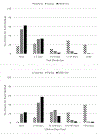Emerging Trends in Cannabis Administration Among Adolescent Cannabis Users
- PMID: 30205931
- PMCID: PMC6408312
- DOI: 10.1016/j.jadohealth.2018.07.012
Emerging Trends in Cannabis Administration Among Adolescent Cannabis Users
Abstract
Purpose: The legal landscape of cannabis availability and use in the United States is rapidly changing. As the heterogeneity of cannabis products and methods of use increases, more information is needed on how these changes affect use, especially in vulnerable populations such as youth.
Methods: A national sample of adolescents aged 14-18 years (N = 2,630) were recruited online through advertisements displayed on Facebook and Instagram to complete a survey on cannabis. The survey assessed patterns of edible use, vaping, and smoking cannabis, and the associations among these administration routes and use of other substances.
Results: The most frequent and consistent route of cannabis use was smoking (99% lifetime), with substantial numbers reporting vaping (44% lifetime) and edible use (61% lifetime). The majority of those who had experimented with multiple routes of cannabis administration continued to prefer smoking, and the most common pattern of initiation was smoking, followed by edibles and then vaping. In addition to cannabis use, adolescents reported high rates of nicotine use and substantial use of other substances. Adolescents who used more cannabis administration routes tended to also report higher frequency of other substances tried.
Conclusions: Additional work is needed to determine whether the observed adolescent cannabis administration patterns are similar across different samples and sampling methods as well as how these trends change over time with extended exposure to new products and methods. The combined knowledge gained via diverse sampling strategies will have important implications for the development of regulatory policy and prevention and intervention efforts.
Keywords: Administration methods; Adolescent; Cannabis; Edibles; Marijuana; Nicotine; Smoking; Tobacco; Vaping; Youth.
Published by Elsevier Inc.
Figures

Similar articles
-
U.S. cannabis legalization and use of vaping and edible products among youth.Drug Alcohol Depend. 2017 Aug 1;177:299-306. doi: 10.1016/j.drugalcdep.2017.02.017. Epub 2017 Jun 9. Drug Alcohol Depend. 2017. PMID: 28662974 Free PMC article.
-
Smoking, vaping, eating: Is legalization impacting the way people use cannabis?Int J Drug Policy. 2016 Oct;36:141-7. doi: 10.1016/j.drugpo.2016.02.022. Epub 2016 Mar 2. Int J Drug Policy. 2016. PMID: 26992484 Free PMC article.
-
Online survey characterizing vaporizer use among cannabis users.Drug Alcohol Depend. 2016 Feb 1;159:227-33. doi: 10.1016/j.drugalcdep.2015.12.020. Epub 2015 Dec 30. Drug Alcohol Depend. 2016. PMID: 26774946 Free PMC article.
-
Cardiovascular and Respiratory Effects of Cannabis Use by Route of Administration: A Systematic Review.Subst Use Misuse. 2024;59(9):1331-1351. doi: 10.1080/10826084.2024.2341317. Epub 2024 Apr 21. Subst Use Misuse. 2024. PMID: 38644600
-
Cannabis vaping: Understanding the health risks of a rapidly emerging trend.Paediatr Child Health. 2020 Jun;25(Suppl 1):S16-S20. doi: 10.1093/pch/pxaa016. Epub 2020 Jun 15. Paediatr Child Health. 2020. PMID: 33390752 Free PMC article. Review.
Cited by
-
Flavored Cannabis Product Use Among Adolescents in California.Prev Chronic Dis. 2021 Jun 3;18:E54. doi: 10.5888/pcd18.210026. Prev Chronic Dis. 2021. PMID: 34081578 Free PMC article.
-
Longitudinal trajectories of E-cigarette use among adolescents: A 5-year, multiple cohort study of vaping with and without marijuana.Prev Med. 2021 Sep;150:106670. doi: 10.1016/j.ypmed.2021.106670. Epub 2021 Jun 1. Prev Med. 2021. PMID: 34087321 Free PMC article.
-
Characteristics of Adults Who Use Both Marijuana and E-Cigarette, or Vaping, Products: A Cross-Sectional Study, Utah, 2018.Public Health Rep. 2022 Jul-Aug;137(4):695-701. doi: 10.1177/00333549211018679. Epub 2021 May 26. Public Health Rep. 2022. PMID: 34039118 Free PMC article.
-
Assessment of cognitive and psychomotor impairment, subjective effects, and blood THC concentrations following acute administration of oral and vaporized cannabis.J Psychopharmacol. 2021 Jul;35(7):786-803. doi: 10.1177/02698811211021583. Epub 2021 May 28. J Psychopharmacol. 2021. PMID: 34049452 Free PMC article.
-
Frequency of adolescent cannabis smoking and vaping in the United States: Trends, disparities and concurrent substance use, 2017-19.Addiction. 2022 Aug;117(8):2316-2324. doi: 10.1111/add.15912. Epub 2022 May 19. Addiction. 2022. PMID: 35588004 Free PMC article.
References
-
- Johnston LD, O’Malley PM, Meich RA, Bachman JG, Schulenberg JE. Monitoring the Future national survey results on drug use, 1975–2016: Overview, key findings on adolescent drug use. Ann Arbor: The University of Michigan; 2017.
-
- Okaneku J, Vearrier D, McKeever RG, LaSala GS, Greenberg MI. Change in perceived risk associated with marijuana use in the United States from 2002 to 2012. Clin Toxicol (Phila) 2015; 53 (3):151–155. - PubMed
-
- Unit RMHSI. The Legalization of Marijuana in Colorado: The Impact October 2017. 2017.
Publication types
MeSH terms
Grants and funding
LinkOut - more resources
Full Text Sources
Other Literature Sources
Research Materials

